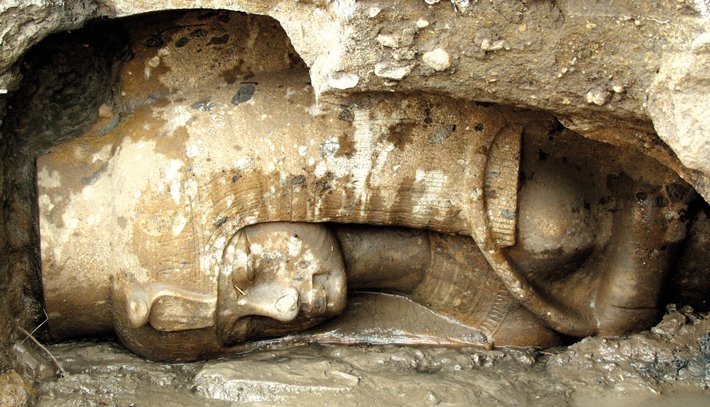In 2017, a remarkable alabaster statue of Queen Tiye, the respected Great Royal Wife of Amenhotep III (who reigned from circa 1398–1338 B.C.), was unearthed at Kom al-Hittan on the west bank of Luxor. This unexpected discovery was made by a European archaeological mission led by Dr. Hourig Sourouzian, during the relocation of a colossal statue of Amenhotep III. The finely detailed statue of Queen Tiye was found alongside the king, emphasizing her critical role and prominence within his reign.
Queen Tiye’s Influence and Legacy
Queen Tiye, one of the most powerful women of ancient Egypt, played a pivotal role in both political and religious life during her husband’s reign. As the Great Royal Wife, she wielded immense influence, not only as Amenhotep III’s trusted advisor but also in diplomatic matters. Her participation in state affairs, her wisdom, and her ability to foster peaceful relations with foreign powers cemented her as a key figure in Egypt’s royal court.

The discovery of her statue beside Amenhotep III adds to the existing understanding of her cultural significance. It reaffirms that she was not only respected but also revered, being depicted alongside the king in monumental statues, which were symbolic of her equal standing within the royal family.
The Excavation at Kom al-Hittan
The excavation at Kom al-Hittan, the site of Amenhotep III’s Mortuary Temple, has yielded multiple important discoveries, including statues of both Amenhotep III and Queen Tiye. This particular alabaster statue of Tiye was found during efforts to preserve and relocate a massive statue of her husband. The discovery, while accidental, highlights the detailed artistry and architectural brilliance of the 18th Dynasty.
Interestingly, in the same year, a black granite statue of Queen Tiye was also found at the site, further illustrating the queen’s enduring legacy and the artistic representation of her power. These statues serve as testaments to her high status and the reverence she commanded, both during and after her lifetime.
Insights into the 18th Dynasty’s Art and Culture
The Mortuary Temple of Amenhotep III, where these statues were found, stands as a testament to the architectural and artistic achievements of the 18th Dynasty, a period marked by grandeur and cultural flourishing. The temple complex, once a magnificent structure, was designed to honor the king in his afterlife. The discovery of Queen Tiye’s statue, in particular, offers valuable insight into how the queen was immortalized in royal art.
The intricate carvings and fine craftsmanship of the statues emphasize the attention to detail and reverence given to members of the royal family. The proximity of Tiye’s statue to that of Amenhotep III symbolizes their close relationship, showcasing her significant influence not only as a queen but as a revered figure of Egypt’s ruling dynasty.
Conclusion
The 2017 discovery of Queen Tiye’s alabaster statue at Kom al-Hittan is a significant contribution to the understanding of ancient Egypt’s royal history and artistic legacy. Queen Tiye’s role as a powerful political figure and her continued presence in Egypt’s monumental art demonstrate her lasting impact. This remarkable find, alongside the broader excavation at the Mortuary Temple of Amenhotep III, helps to further illuminate the power and prominence of the 18th Dynasty and its royal family.

